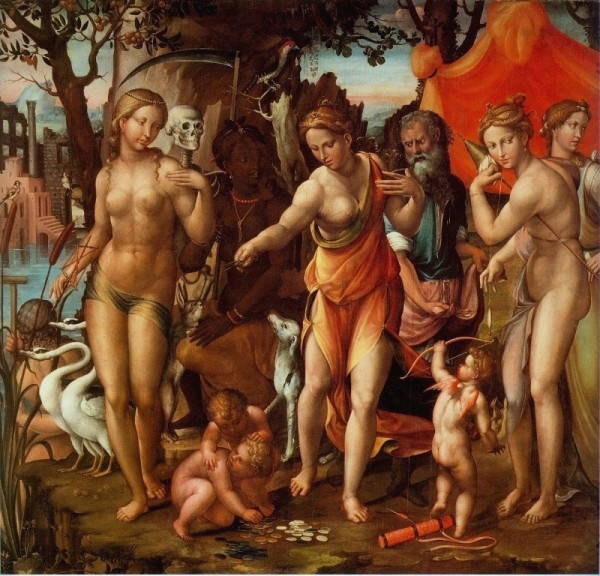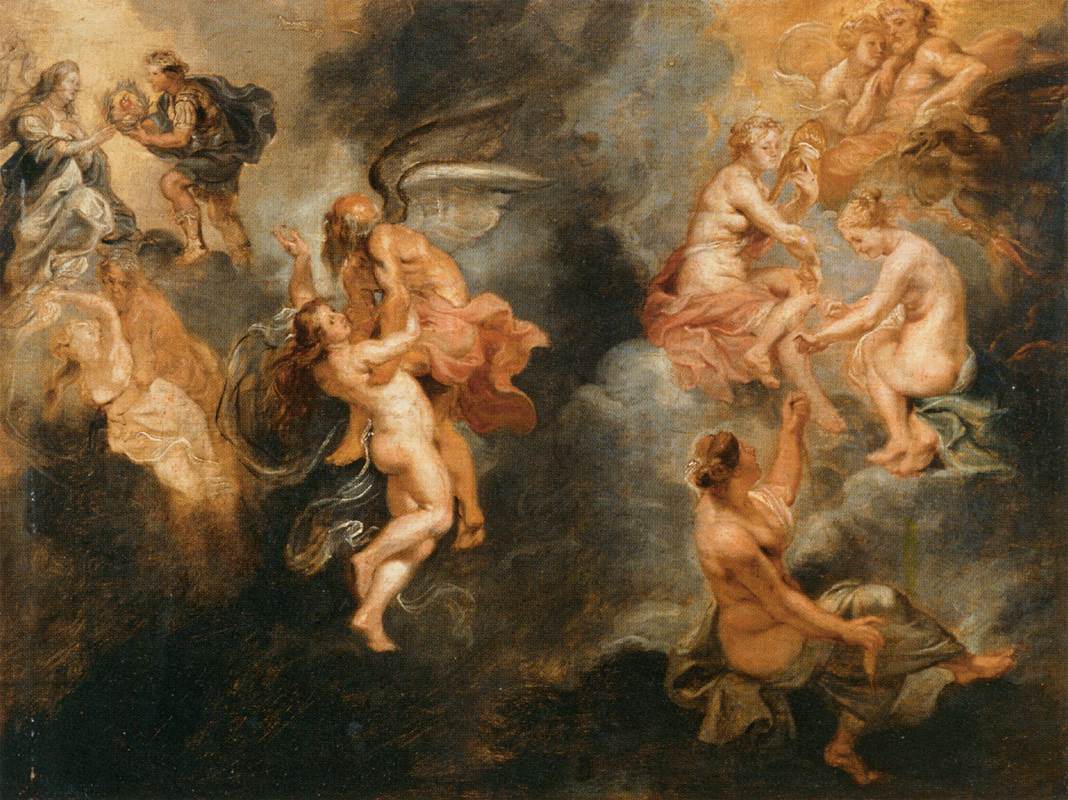Parcae on:
[Wikipedia]
[Google]
[Amazon]


 In
In
 One of the sources for the Parcae is ''
One of the sources for the Parcae is ''


 In
In ancient Roman religion
Religion in ancient Rome consisted of varying imperial and provincial religious practices, which were followed both by the Roman people, people of Rome as well as those who were brought under its rule.
The Romans thought of themselves as high ...
and myth
Myth is a genre of folklore consisting primarily of narratives that play a fundamental role in a society. For scholars, this is very different from the vernacular usage of the term "myth" that refers to a belief that is not true. Instead, the ...
, the Parcae (singular, Parca) were the female personification
Personification is the representation of a thing or abstraction as a person, often as an embodiment or incarnation. In the arts, many things are commonly personified, including: places, especially cities, National personification, countries, an ...
s of destiny
Destiny, sometimes also called fate (), is a predetermined course of events. It may be conceived as a predetermined future, whether in general or of an individual.
Fate
Although often used interchangeably, the words ''fate'' and ''destiny'' ...
who directed the lives (and deaths) of humans and gods. They are often called the Fates
The Fates are a common motif in European polytheism, most frequently represented as a trio of goddesses. The Fates shape the destiny of each human, often expressed in textile metaphors such as spinning fibers into yarn, or weaving threads on a ...
in English, and their Greek equivalent were the Moirai
In ancient Greek religion and Greek mythology, mythology, the Moirai ()often known in English as the Fateswere the personifications of fate, destiny. They were three sisters: Clotho (the spinner), Lachesis (mythology), Lachesis (the allotter ...
. They did not control a person's actions except when they are born, when they die, and how much they suffer.
The Parcae recorded the metaphorical thread of life of every mortal and immortal from birth to death. Even the gods feared them, and by some sources Jupiter
Jupiter is the fifth planet from the Sun and the List of Solar System objects by size, largest in the Solar System. It is a gas giant with a Jupiter mass, mass more than 2.5 times that of all the other planets in the Solar System combined a ...
was also subject to their power.
Nona was supposed to determine a person's lifespan on the ''dies lustricus
In ancient Rome the ''dies lustricus'' ("day of Lustratio, lustration" or "purification day") was a traditional naming ceremony in which an infant was purified and given a ''praenomen'' (given name). This occurred on the eighth day for girls and t ...
'', that is, the day on which the name of the child was chosen, which occurred on the ninth day from birth for a male and the eighth for a female.
The recurrence of the nundinae
The nundinae (, ), sometimes anglicized to nundines,. were the market days of the ancient Roman calendar, forming a kind of weekend including, for a certain period, rest from work for the ruling class ( patricians).
The nundinal cycle, marke ...
was also considered a '' dies festus'' and as such ''nefas
The vocabulary of ancient Roman religion was highly specialized. Its study affords important information about the religion, traditions and beliefs of the ancient Romans. This legacy is conspicuous in European cultural history in its influence on ...
'' by some Roman scholars as Julius Caesar
Gaius Julius Caesar (12 or 13 July 100 BC – 15 March 44 BC) was a Roman general and statesman. A member of the First Triumvirate, Caesar led the Roman armies in the Gallic Wars before defeating his political rival Pompey in Caesar's civil wa ...
and Cornelius Labeo
Cornelius Labeo was an ancient Roman theologian and antiquarian who wrote on such topics as the Roman calendar and the teachings of Etruscan religion ''(Etrusca disciplina)''. His works survive only in fragments and '' testimonia.''
He has been da ...
, because on it the ''flaminica dialis
In ancient Roman religion, the was the high priest of Jupiter. The term ''Dialis'' is related to ''Diespiter'', an Old Latin form of the name ''Jupiter''. There were 15 ''flamines'', of whom three were ''flamines maiores'', serving the three ...
'' offered the sacrifice of a goat to Jupiter in the Regia
The Regia ("Royal house") was a two-part structure in Ancient Rome lying along the Via Sacra at the edge of the Roman Forum that originally served as the residence or one of the main headquarters of kings of Rome and later as the office of the ...
.
According to some treatments, the Parcae seem to be more powerful than many, or perhaps even all, of the gods: "The power of the Parcae was great and extensive. Some suppose that they were subjected to none of the gods but Jupiter; while others support that even Jupiter himself was obedient to their commands; and indeed we see the father of the gods, in Homer's Iliad, unwilling to see Patroclus perish, yet obliged, by the superior power of the Fates, to abandon him to his destiny." Similarly: "We have the clearest evidence of the poet for it, that whatever happens to us is under the influence of the Parcae. Jupiter himself can not interfere to save his son Sarpedon."
Names and sources
The names of the three Parcae are: * Nona (Greek equivalent ''Clotho
Clotho (; ) or Klotho, is a mythological figure. She was one of the Three Fates or Moirai. In ancient Greek mythology, she spins the thread of human life, her sisters draw out ( Lachesis) and cut ( Atropos) the thread. She also made major dec ...
''), who spun the thread of life from her distaff
A distaff (, , also called a rock"Rock." ''The Oxford English Dictionary''. 2nd ed. 1989.) is a tool used in spinning. It is designed to hold the unspun fibers, keeping them untangled and thus easing the spinning process. It is most commonly use ...
onto her spindle
Spindle may refer to:
Textiles and manufacturing
* Spindle (textiles), a straight spike to spin fibers into yarn
* Spindle (tool), a rotating axis of a machine tool
Biology
* Common spindle and other species of shrubs and trees in genus ''Euonym ...
;John Day, ''God's Conflict With the Dragon and the Sea: Echoes of a Canaanite Myth in the Old Testament'', CUP Archive, 1985, p. 308.
* Decima (Greek ''Lachesis
Lachesis ( ; ; from , 'to obtain by lot, by fate, or by the will of the gods'), in ancient Greek religion, was the middle of the Three Fates, or Moirai; the others were her sisters, Clotho and Atropos. Normally seen clothed in white, Laches ...
''), who measured the thread of life with her rod;
* Morta (Greek ''Atropos
Atropos (; "without turn"), in Greek mythology, was the third of the Three Fates or Moirai, goddesses of fate and destiny. Her Roman equivalent was Morta.
Atropos was one of the Three Fates and was known as "the Inflexible One." It was Atro ...
''), who cut the thread of life and chose the manner of a person's death.
The earliest extant documents referencing these deities are three small stelae
A stele ( ) or stela ( )The plural in English is sometimes stelai ( ) based on direct transliteration of the Greek, sometimes stelae or stelæ ( ) based on the inflection of Greek nouns in Latin, and sometimes anglicized to steles ( ) or stela ...
''(cippi)'' found near ancient Lavinium
Lavinium was a port city of Latium, to the south of Rome, midway between the Tiber river at Ostia Antica, Ostia and Antium. The coastline then, as now, was a long strip of beach. Lavinium was on a hill at the southernmost edge of the ''Silva La ...
shortly after World War II
World War II or the Second World War (1 September 1939 – 2 September 1945) was a World war, global conflict between two coalitions: the Allies of World War II, Allies and the Axis powers. World War II by country, Nearly all of the wo ...
. They bear the inscription:
''Neuna fata, Neuna dono, Parca Maurtia dono''The names of two of the three Roman Parcae are recorded (''Neuna'' = Nona, ''Maurtia'' = Morta) and connected to the concept of ''fata''.L. L. Tels De Jong ''Sur quelques divinites romaines de la naissance et de la prophetie'' 1959 pp. 67–130.
 One of the sources for the Parcae is ''
One of the sources for the Parcae is ''Metamorphoses
The ''Metamorphoses'' (, , ) is a Latin Narrative poetry, narrative poem from 8 Common Era, CE by the Ancient Rome, Roman poet Ovid. It is considered his ''Masterpiece, magnum opus''. The poem chronicles the history of the world from its Cre ...
'' by Ovid
Publius Ovidius Naso (; 20 March 43 BC – AD 17/18), known in English as Ovid ( ), was a Augustan literature (ancient Rome), Roman poet who lived during the reign of Augustus. He was a younger contemporary of Virgil and Horace, with whom he i ...
, II 654, V 532, VIII 452, XV 781. Another source is Aeneid
The ''Aeneid'' ( ; or ) is a Latin Epic poetry, epic poem that tells the legendary story of Aeneas, a Troy, Trojan who fled the Trojan War#Sack of Troy, fall of Troy and travelled to Italy, where he became the ancestor of the Ancient Rome ...
by Virgil
Publius Vergilius Maro (; 15 October 70 BC21 September 19 BC), usually called Virgil or Vergil ( ) in English, was an ancient Rome, ancient Roman poet of the Augustan literature (ancient Rome), Augustan period. He composed three of the most fa ...
, in the opening of Book I.
See also
*Fates
The Fates are a common motif in European polytheism, most frequently represented as a trio of goddesses. The Fates shape the destiny of each human, often expressed in textile metaphors such as spinning fibers into yarn, or weaving threads on a ...
* Norns
The Norns ( , plural: ) are a group of deities in Norse mythology responsible for shaping the course of human destinies.''Nordisk familjebok'' (1907)
The Norns are often represented as three goddesses known as Urd ( Urðr), Verðandi, and S ...
, equivalent of the Fates in Norse mythology
Norse, Nordic, or Scandinavian mythology, is the body of myths belonging to the North Germanic peoples, stemming from Old Norse religion and continuing after the Christianization of Scandinavia as the Nordic folklore of the modern period. The ...
* List of Roman birth and childhood deities
In ancient Roman religion, birth and childhood deities were thought to care for every aspect of conception, pregnancy, childbirth, and child development. Some major deities of Roman religion had a specialized function they contributed to this ...
References
Further reading
* Thomas Blisniewski: ''Kinder der dunkelen Nacht. Die Ikonographie der Parzeten Mittelalter bis zum späten XVIII.'' Jahrhundert. Thesis. Cologne 1992. Berlin 1992External links
* {{Authority control Roman goddesses Time and fate goddesses Triple goddesses Destiny Textiles in folklore Personifications in Roman mythology